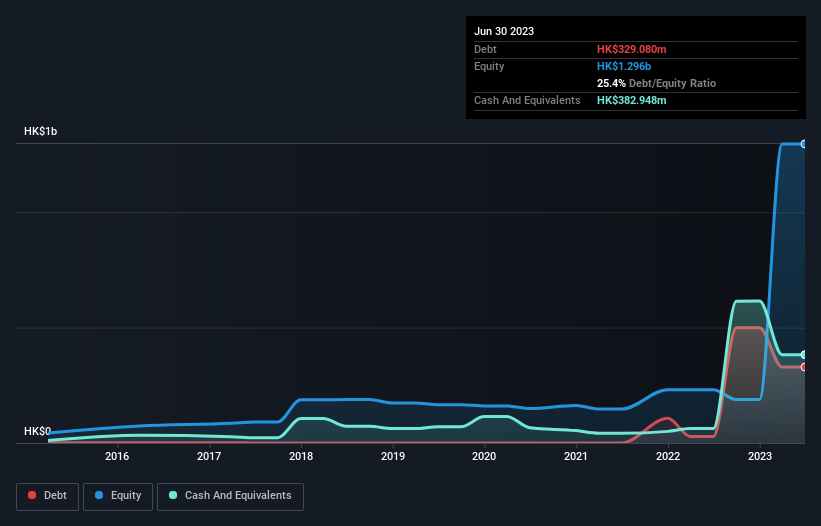- Hong Kong
- /
- Construction
- /
- SEHK:1735
Health Check: How Prudently Does Central New Energy Holding Group (HKG:1735) Use Debt?

Warren Buffett famously said, 'Volatility is far from synonymous with risk.' When we think about how risky a company is, we always like to look at its use of debt, since debt overload can lead to ruin. Importantly, Central New Energy Holding Group Limited (HKG:1735) does carry debt. But is this debt a concern to shareholders?
What Risk Does Debt Bring?
Debt assists a business until the business has trouble paying it off, either with new capital or with free cash flow. Part and parcel of capitalism is the process of 'creative destruction' where failed businesses are mercilessly liquidated by their bankers. However, a more common (but still painful) scenario is that it has to raise new equity capital at a low price, thus permanently diluting shareholders. Of course, debt can be an important tool in businesses, particularly capital heavy businesses. When we examine debt levels, we first consider both cash and debt levels, together.
Check out our latest analysis for Central New Energy Holding Group
How Much Debt Does Central New Energy Holding Group Carry?
As you can see below, at the end of June 2023, Central New Energy Holding Group had HK$329.1m of debt, up from HK$28.0m a year ago. Click the image for more detail. But it also has HK$382.9m in cash to offset that, meaning it has HK$53.9m net cash.

How Healthy Is Central New Energy Holding Group's Balance Sheet?
The latest balance sheet data shows that Central New Energy Holding Group had liabilities of HK$941.3m due within a year, and liabilities of HK$232.0m falling due after that. Offsetting this, it had HK$382.9m in cash and HK$1.48b in receivables that were due within 12 months. So it actually has HK$694.5m more liquid assets than total liabilities.
This short term liquidity is a sign that Central New Energy Holding Group could probably pay off its debt with ease, as its balance sheet is far from stretched. Simply put, the fact that Central New Energy Holding Group has more cash than debt is arguably a good indication that it can manage its debt safely. When analysing debt levels, the balance sheet is the obvious place to start. But it is Central New Energy Holding Group's earnings that will influence how the balance sheet holds up in the future. So if you're keen to discover more about its earnings, it might be worth checking out this graph of its long term earnings trend.
In the last year Central New Energy Holding Group wasn't profitable at an EBIT level, but managed to grow its revenue by 102%, to HK$2.7b. So its pretty obvious shareholders are hoping for more growth!
So How Risky Is Central New Energy Holding Group?
By their very nature companies that are losing money are more risky than those with a long history of profitability. And in the last year Central New Energy Holding Group had an earnings before interest and tax (EBIT) loss, truth be told. Indeed, in that time it burnt through HK$859m of cash and made a loss of HK$20m. While this does make the company a bit risky, it's important to remember it has net cash of HK$53.9m. That kitty means the company can keep spending for growth for at least two years, at current rates. Importantly, Central New Energy Holding Group's revenue growth is hot to trot. While unprofitable companies can be risky, they can also grow hard and fast in those pre-profit years. For riskier companies like Central New Energy Holding Group I always like to keep an eye on the long term profit and revenue trends. Fortunately, you can click to see our interactive graph of its profit, revenue, and operating cashflow.
Of course, if you're the type of investor who prefers buying stocks without the burden of debt, then don't hesitate to discover our exclusive list of net cash growth stocks, today.
If you're looking to trade Central New Energy Holding Group, open an account with the lowest-cost platform trusted by professionals, Interactive Brokers.
With clients in over 200 countries and territories, and access to 160 markets, IBKR lets you trade stocks, options, futures, forex, bonds and funds from a single integrated account.
Enjoy no hidden fees, no account minimums, and FX conversion rates as low as 0.03%, far better than what most brokers offer.
Sponsored ContentNew: AI Stock Screener & Alerts
Our new AI Stock Screener scans the market every day to uncover opportunities.
• Dividend Powerhouses (3%+ Yield)
• Undervalued Small Caps with Insider Buying
• High growth Tech and AI Companies
Or build your own from over 50 metrics.
Have feedback on this article? Concerned about the content? Get in touch with us directly. Alternatively, email editorial-team (at) simplywallst.com.
This article by Simply Wall St is general in nature. We provide commentary based on historical data and analyst forecasts only using an unbiased methodology and our articles are not intended to be financial advice. It does not constitute a recommendation to buy or sell any stock, and does not take account of your objectives, or your financial situation. We aim to bring you long-term focused analysis driven by fundamental data. Note that our analysis may not factor in the latest price-sensitive company announcements or qualitative material. Simply Wall St has no position in any stocks mentioned.
About SEHK:1735
Central New Energy Holding Group
An investment holding company, engages in the business of foundation, superstructure building, and other construction works in Hong Kong and the People’s Republic of China.
Proven track record with imperfect balance sheet.
Market Insights
Community Narratives



